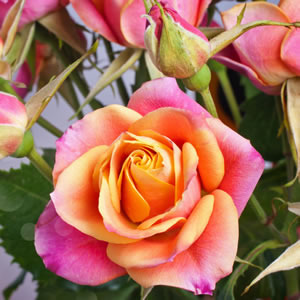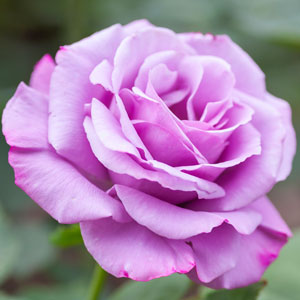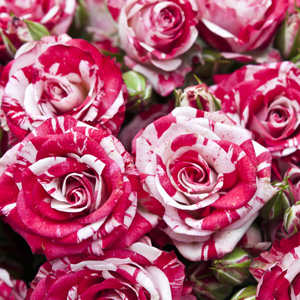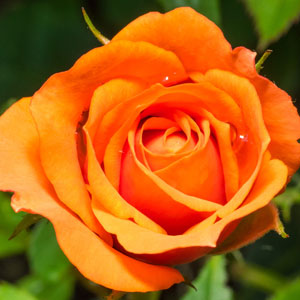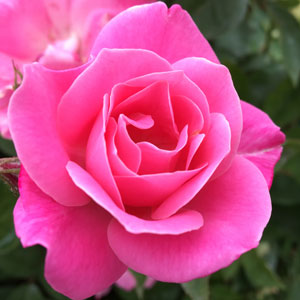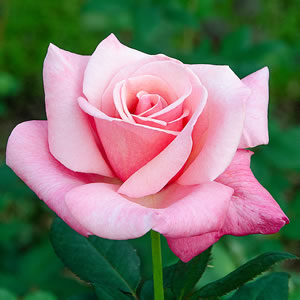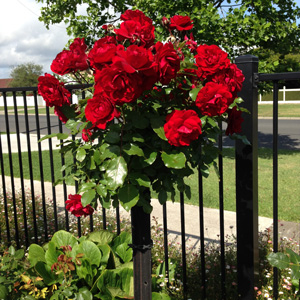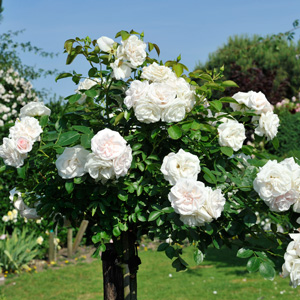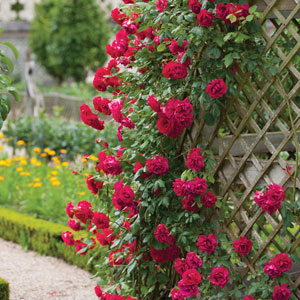Rose Growing Guide

What is Rose?
Rose (Rosa spp.) is a woody flowering perennial. It is part of the Rosaceae family, where most rose species are native to Asia, with smaller numbers being native to North America and a few to Europe and northwest Africa. With hundreds of different species and many thousands of cultivars there are bunches of different roses to choose from. Roses are versatile and come in many forms such as standards, miniature compact shrubs, ground covers, climbers and come with thorns or are thornless. Their flowers come in many shades are often fragrant, vary in size and are usually large and showy.
All roses require an open, sunny and well drained position with at least 5 hours of sun per day, preferably more. Although shaded areas will allow roses to do well, the quantity of flowers will diminish with the percentage of shade. Shaded parts of the garden are more liable to attacks from fungus diseases as the plants remain wet for too long after rains or dewy nights. Protection from wind is essential for good blooms but remember to allow for movement of air. Avoid planting too close to established shrubs and trees.
If you buy bare rooted roses when you get home soak the roots in water overnight. Plant the rose the following day. The most important part is not letting the roots dry out. If you are not ready to plant right away then you will need to heel in the rose. This means select an open space in the garden (does not need to be a large space just enough to accommodate the rose and a little wriggle room), dig a hole and plant all your bare rooted roses in it. Water in well. Do not leave too long as new roots will begin to grow and they do not like to be disturbed.
Benefits of Growing Rose
Roses are best known as ornamental plants which are grown in gardens for their attractive appearance, flowers and fragrance. They are also used as cut flowers and is widely sort after in the commercial trade. Highly fragrant and with excellent vase life means the rose is a beautiful flower to enjoy indoors. Roses are also used in perfumes, food and drink or even in art. They are also seen for a long time as a symbol of love and passion.
How to Grow Rose
Climatic Zones
Cool to mild tropics.
Plant Size
Sizes vary.
When To Plant Rose
Plant in Winter. The ideal time for planting bare rooted roses in Australia is June and July.
Soil Preparation
Roses can be grown successfully in many soil types. The best soils are medium to heavy loam to about 35cm minimum depth, over a good clay subsoil. The important thing to remember is that light sandy soils retain less moisture and nutrients. If your soil quality is poor then the addition of well rotted animal manure and a small amount of blood and bone dug through will help improve the soil. Mulching is advisable with all soil types as it eliminates many problems, such as less watering and weeding and also retains better average soil temperature. Some mulches to use: Pea straw, lucerne, tan or pine bark, leaf mould and peat moss,.
How To Plant Rose
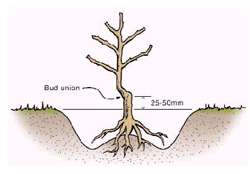
Plant in a full sun position that has at least 5 house of sun a day, more if possible.
The rose bed should have been dug over many times prior to planting. Dig a hole large enough to take the roots, which should be placed down and outwards over a small mound at the bottom of the hole. A hole approximately 30cm wide by 25cm deep should be sufficient. Cover with soil and firm down moderately. Water in well. The bud graft or bud union should remain approximately 5cm above soil level. Do not use fertilisers at planting time, as this may burn the roots. However, the addition of well rotted animal manure and a small amount of blood and bone well dug in is beneficial.
Rose Plant Care
Roses are generally very hardy plants that will survive through our hot Summers however they like to have moist soil at all times. Regularly water during hot periods to keep the moist levels up. Long soaking waterings is better than quick frequent ones as the water needs to seep down to the root system. Make sure that if using a sprinkler system that the foliage has had time to dry before nightfall. Wet foliage is more susceptible to diseases during the cooler months.
Make sure that your roses are mulched. This helps to keep the moisture in, keeps the roses roots cool and prevents weeds from growing.
Roses are heavy feeders and need to be fed every season. They can be fed with a handful of pelletised organic manure or a rose fertiliser (follow the instructions on the packaging). Do not feed in March because the plants should be hardening off for their Winter dormancy.
Pruning
Pruning is important when keeping roses and should be done when the plant is dormant during Winter. The aim is to promote new healthy growth next season and to remove dead and diseased wood. Another reason for pruning is to keep your rose in a particular shape or keep it at a manageable size.
Hard pruning: Hard pruning is used for newly planted roses or to rejuvenate neglected roses. Cut stems back to only 3 or 4 buds.
Moderate pruning: Moderate pruning is used for all established roses. Stems are cut back to half their length.
Light pruning:Light pruning is used with very vigorous or fast growing varieties. Stems are cut back to two-thirds their length, so that the main stems are merely tipped.
Step by step pruning…
- Remove all dead, old or diseased stems.
- Remove any old branches (they’ll look dull and grey whilst new growth is red/green and shiny). Cut the stem off at the bud union.
- Cut out all very thin stems (less than pencil thickness) and branches that cross over each other or are crowding the center of the plant.
- If there are any shoots growing from below the bud graft or bud union (i.e. “suckers”) remove these also.
- Only healthy branches now remain. Prune these to the length required depending on whether you are pruning hard or light. When making your cuts, cut on a 45 angle about 1cm above an outward facing bud.
Pests and diseases
With most diseases of roses, prevention is the best cure. Most diseases can be prevented but not always cured. While it would be desirable to grow roses without spraying, they do need treating to retain good health and vitality and consequently better quality flowers. Fungus diseases such as black spot and mildew are more prevalent in the humid areas of Australia.
The following suggestions are what we have found to be most satisfactory.
Black Spot – Probably the most troublesome disease because if left unattended the plant will become defoliated and consequently lose vigour and become debilitated. It is important to remember that Black Spot cannot be cured, so a preventive spraying program is necessary. Immediately after Winter pruning spray the roses and surrounding ground with Bordeaux or Lime Sulphur, this helps eradicate any fungus spores left on the pruned plant. In early Spring, when good growth commences, start spraying thoroughly every 10 days. The following fungicide sprays are considered effective: Triforine (Saprol), Mancozeb, Dithane M45, Baycor, Systhane. A good organic control for fungal infections is 1 part full cream milk to 10 parts water and sprayed onto foliage every 7 to 14 days.
Mildew – Mainly effects the young growth and is usually at its worst in sub-tropical areas where night air is cool and dews are prevalent. Spray every 10 days or when necessary with Nimrod, Triforine (Saprol), or Rubigan. For both Black Spot and Powdery Mildew avoid watering roses overhead in the late afternoon or evening, as night dampness is conducive to the spread of fungus diseases.
Rust – Appears as rust coloured spots or swellings on the underside of leaves and occasionally on the stems. Not very common, but if noticed spray the undersides of leaves with Rubigan, Triforine, or Zineb.
Insects – Aphids, two spotted mite (Red spider mite) and other sucking insects can be controlled with the following: Rogor, Metasystox, Mavrik, Torgue. These are all systemic sprays, rotate usage to avoid insects becoming partly immune.
Caterpillars & Chewing Pests- Can be eradicated using Cabaryl (Septene) or Bugmaster (Sevin).
Recommended Rose Varieties
Roses are one of the most popular flowering plants in the world.

